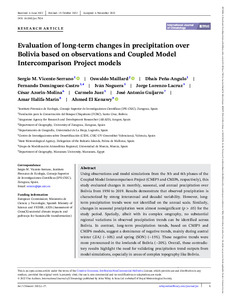Por favor, use este identificador para citar o enlazar este ítem:
http://hdl.handle.net/20.500.11765/14378
Evaluation of long-term changes in precipitation over Bolivia based on observations and Coupled Model Intercomparison Project models
Registro completo de metadatos
| Campo DC | Valor | Lengua/Idioma |
|---|---|---|
| dc.contributor.author | Vicente Serrano, Sergio Martín | es_ES |
| dc.contributor.author | Maillard, Oswaldo | es_ES |
| dc.contributor.author | Peña Angulo, Dhais | es_ES |
| dc.contributor.author | Domínguez Castro, Fernando | es_ES |
| dc.contributor.author | Noguera, Iván | es_ES |
| dc.contributor.author | Lorenzo-Lacruz, Jorge | es_ES |
| dc.contributor.author | Azorín Molina, César | es_ES |
| dc.contributor.author | Juez, Carmelo | es_ES |
| dc.contributor.author | Guijarro Pastor, José Antonio | es_ES |
| dc.contributor.author | Halifa Marín, Amar | es_ES |
| dc.contributor.author | El-Kenawy, Ahmed | es_ES |
| dc.date.accessioned | 2023-02-20T09:48:41Z | - |
| dc.date.available | 2023-02-20T09:48:41Z | - |
| dc.date.issued | 2022 | - |
| dc.identifier.citation | International Journal of Climatology. 2022 | es_ES |
| dc.identifier.issn | 0899-8418 | - |
| dc.identifier.issn | 1097-0088 | - |
| dc.identifier.uri | http://hdl.handle.net/20.500.11765/14378 | - |
| dc.description.abstract | Using observations and model simulations from the 5th and 6th phases of the Coupled Model Intercomparison Project (CMIP5 and CMIP6, respectively), this study evaluated changes in monthly, seasonal, and annual precipitation over Bolivia from 1950 to 2019. Results demonstrate that observed precipitation is characterized by strong interannual and decadal variability. However, long-term precipitation trends were not identified on the annual scale. Similarly, changes in seasonal precipitation were almost nonsignificant (p > .05) for the study period. Spatially, albeit with its complex orography, no substantial regional variations in observed precipitation trends can be identified across Bolivia. In contrast, long-term precipitation trends, based on CMIP5 and CMIP6 models, suggest a dominance of negative trends, mainly during austral winter (JJA) (−10%) and spring (SON) (−15%). These negative trends were more pronounced in the lowlands of Bolivia (−20%). Overall, these contradictory results highlight the need for validating precipitation trend outputs from model simulations, especially in areas of complex topography like Bolivia. | es_ES |
| dc.description.sponsorship | This work was sup-ported by the research projects CGL2017-82216-R,PCI2019-103631, and PID2019-108589RA-I00, financedby the Spanish Ministry of Science and FEDER, theCROSSDRO project financed by the AXIS (Assessment ofCross(X)-sectorial climate impacts and pathways for Sus-tainable transformation), the JPI-Climate co-funded callof the European Commission, and the LINCGLOBAL-CSIC project (INCGLO0023, RED-CLIMA). | es_ES |
| dc.language.iso | eng | es_ES |
| dc.publisher | Wiley | es_ES |
| dc.publisher | Royal Meteorological Society | es_ES |
| dc.rights | Licencia CC: Reconocimiento–NoComercial–SinObraDerivada CC BY-NC-ND | es_ES |
| dc.subject | Bolivia | es_ES |
| dc.subject | CMIP5 | es_ES |
| dc.subject | CMIP6 | es_ES |
| dc.subject | Precipitation | es_ES |
| dc.subject | Trends | es_ES |
| dc.title | Evaluation of long-term changes in precipitation over Bolivia based on observations and Coupled Model Intercomparison Project models | es_ES |
| dc.type | info:eu-repo/semantics/article | es_ES |
| dc.relation.publisherversion | https://doi.org/10.1002/joc.7924 | es_ES |
| dc.rights.accessRights | info:eu-repo/semantics/openAccess | es_ES |
| Colecciones: | Artículos científicos 2019-2022 | |
Ficheros en este ítem:
| Fichero | Descripción | Tamaño | Formato | ||
|---|---|---|---|---|---|
| IJC_Serrano_2022.pdf | 9,58 MB | Adobe PDF |  Visualizar/Abrir |
Los ítems de Arcimis están protegidos por una Licencia Creative Commons, salvo que se indique lo contrario.





